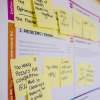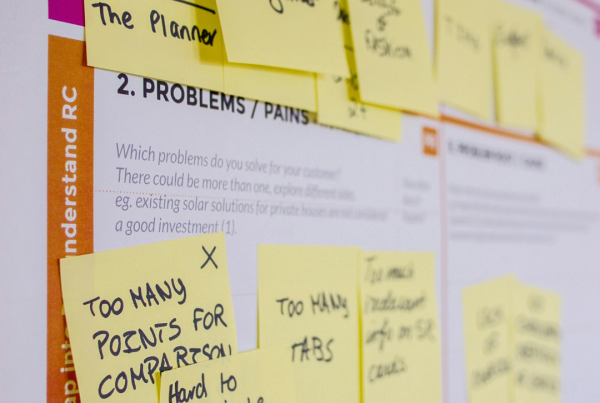What is Product Design?
Product design is a process to create products that meet your customers’ needs and solve their problems through thoughtful, clever, and universal design.
All the products you love to use daily, whether a physical item, software, or app, are products of good design. It’s how big brands like Apple or Google create a base of loyal customers. Product design is a subset of product management, and many companies use design thinking principles to deliver designs that are feasible, viable and functional.
There is another type of product design for manufacturing physical items, called industrial design. Many products are now becoming smart devices, such as the Fitbit smart watches, Google home devices, and smart home appliances, that great design becomes the crux to great products.
In this article, I will be focusing on digital product designs, covering products such as software, apps, websites, etc.
What is the Product Design process?
The product design process will depend on your business processes, company culture and the product you’re designing. A good process marries business goals, user needs, creative design, and feasible technology, giving birth to the best user experience.
The basic flow of a product design process is understanding the user and challenges, researching, ideating, designing, prototyping, and testing. You can divide them into 4,5,6 or more steps. It’s up to you how you want to implement the process.
Some examples of a product design process:
- 4-step process: Define Problem > Discover Solutions > Design Product > Deliver Product.
- 5-step process: Understand > Define > Design > Build Prototype > Test
The process of designing digital products is different to physical products. Industrial designers must consider factors such as materials to use, material costs, product storage solutions, etc.

What is the role of a product designer?
A product designer is someone who understand the customers, recognise the business needs, and can translate them into a design, and is skilled at user testing. They may or may not be highly technical with the implementation of their design.
They are involved throughout the whole product design process, working with other designers, managers, engineers, and developers to create great products.
The best product designers are essentially good problem solvers who understand UX, UI and design systems.
1. What is UX?
UX, or user experience, is the cumulative emotion and perception that your users feel and think when using your products. UX experts are concerned with these questions when designing products:
- How do users feel using the product?
- Was the product easy to understand and use?
- Did it solve their problem?
- Did it help accomplish their task?
- Did it save them time?
- Would they use it again?
2. What is UI?
UI, or user interaction, is made up of the visual elements that users interact with. In a website, software or app, the elements include:
- Navigation elements: Breadcrumbs, menu bar, arrows, etc.
- Input elements: Check box, text box, drop down lists, etc.
- Informational elements: Progress bar, notifications, etc.
3. What is a design system?
A design system is a collection of design components, or a library of visual elements. You can reuse them to build a digital product without having to redesign these elements from scratch.
A design system stores a consistent set of design patterns, style guide and UI assets. They are much like design building bricks that you can customise and integrate into your product. Using design systems help you maintain a steady look and feel across your products.
You can check out several common design systems available in the public domain from companies such as Atlassian, Uber, and Apple.
4. What does a product designer do?
The daily responsibilities of a product designer include:
- Consuming or researching customer data using user interviews, surveys, polls, heatmaps, etc.
- Creating or understanding user personas, a fictional persona that represents the target user, or a subset of targeted users.
- Creating or understanding user journey maps. This is a map detailing the flow of user behaviour before discovering your product and then using your product.

- Developing storyboards, which are illustrations depicting user stories, and their interactions with the product.

- Producing wireframes, which is a blueprint of your product, expressed through sketches of the layout, content, and functionalities.

- Designing and building prototypes. A prototype is a mini model of your product. It can be low or high fidelity, which refers to how realistic the prototype is. The closer to the actual product design, the higher the fidelity.

- Conducting user testing
- Developing design systems
- Collaborating with engineers and designers on product design rollouts
What is the difference between a product designer, product manager and UX designer?
1. Product Managers
Product managers hold the product vision, strategy, roadmap, and pricing. They are also accountable for liaising with other stakeholders like marketing, management, finance. You can say they have an eagle’s eye view of the product from idea to release and support but often do not work on the nitty-gritty details of the product.
2. Product Designers
Product designers hold the design of the whole product or a product feature. They know more about the design, workflow, user behaviour, and UX compared to the product manager. They design solutions, prototypes, and collaborate more closely with developers compared to product managers. At the same time, they must work closely with product managers to help fulfill the business goals.
3. UX Designers
UX designers are focused on the user experience, instead of the UI and business side of the product, which is where UI designers, product designers and managers come in. There are also UX writers, UX researchers and UX engineers under the UX branch. In some companies, UX designer roles are interchangeable with product designer roles.
What is a good product design?
1. Good products are designed for the people who use it
You can never go wrong when you design for the people who will be using it. After all, you’re solving a problem for them, and they are your customers. Thus, product design processes are not linear; they are iterative because you are constantly refining your designs until it hits the right spot.
2. Good products are designed for ease of use
The product is easy to use with a small learning curve for users. In fact, great design makes it almost intuitive to the point that technology fades away in the background. Using the product becomes second nature for your users.
3. Good designs are consistent and on brand.
You’re not only designing for users, but your design must be understood and shared with developers, engineers, UX and UI specialists. This is where design systems come in, maintaining a uniform look and feel across the product.
Your brand is also a promise to your users on what they can expect. And good product design delivers on that promise through aesthetic appeal and functionalities.
4. Good designs are innovative
Innovative designs elevate your product to a higher level among a sea of competitors. It could come from technological advancement, or simply, clever use of design elements such that the final product becomes a trend setter, and later, an industry-wide standard.
5. Good designs are timeless
It comes down to striking the fine balance between current trends and classic appeal. Whether you’re talking about a digital or physical product, it’s true – good designs hardly go out of style.
”"Design adds value faster than it adds costs." – Joel Spolsky, Trello creator
Want to learn more about Product Design?
I’m building an online course that will be jam packed with design tips and tricks based on my years of experience designing digital products. I will walk you through my tailored product design process that will get you creating functional and beautiful products in no time.







